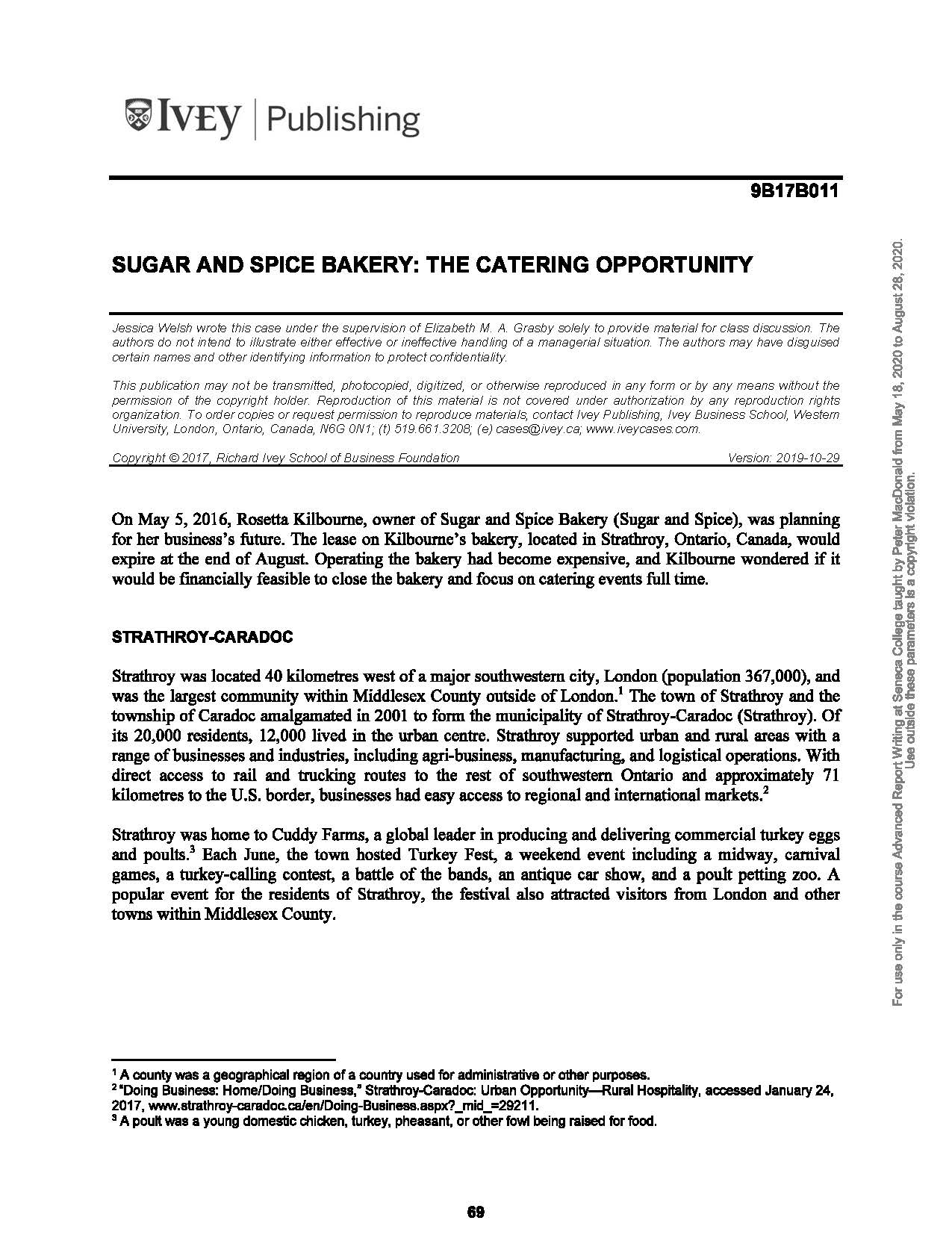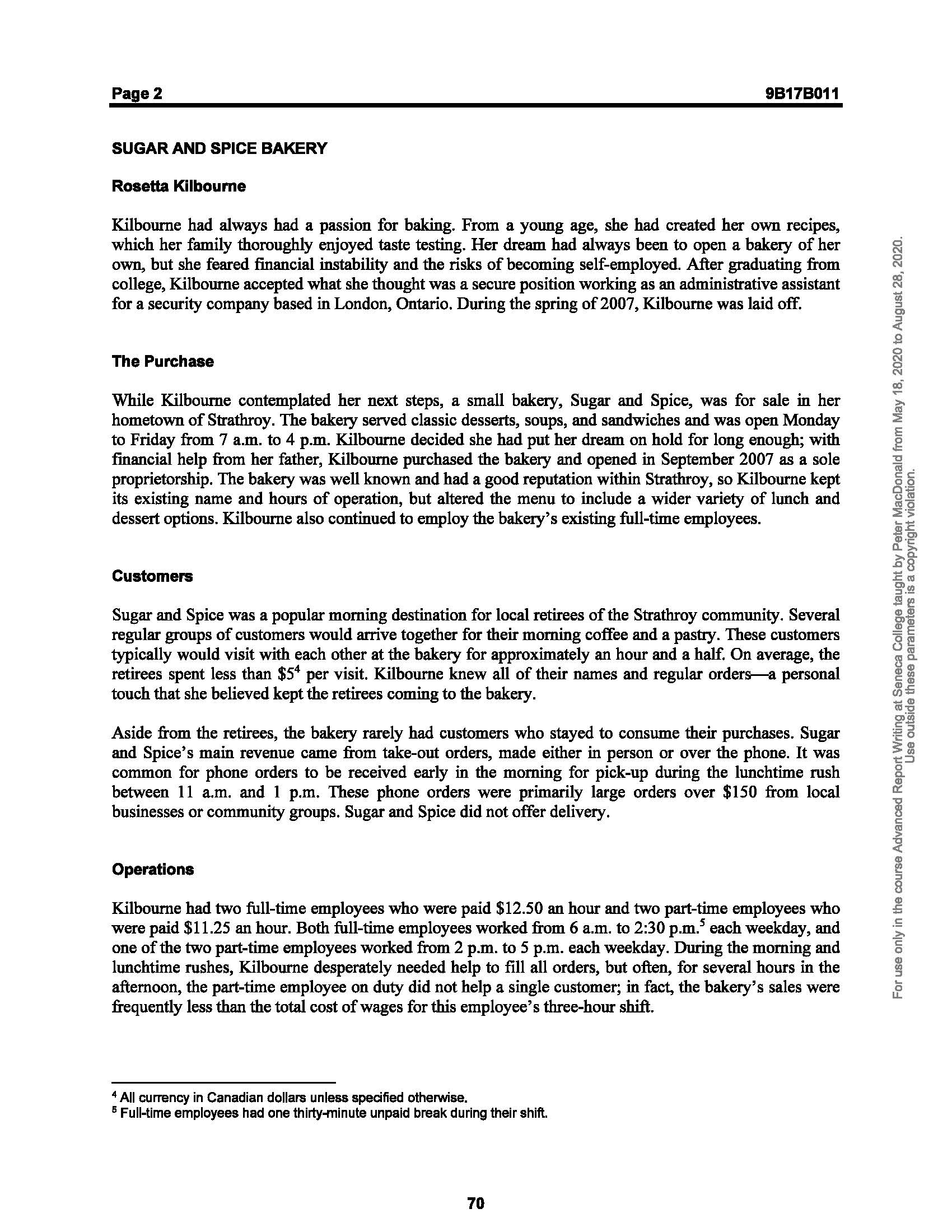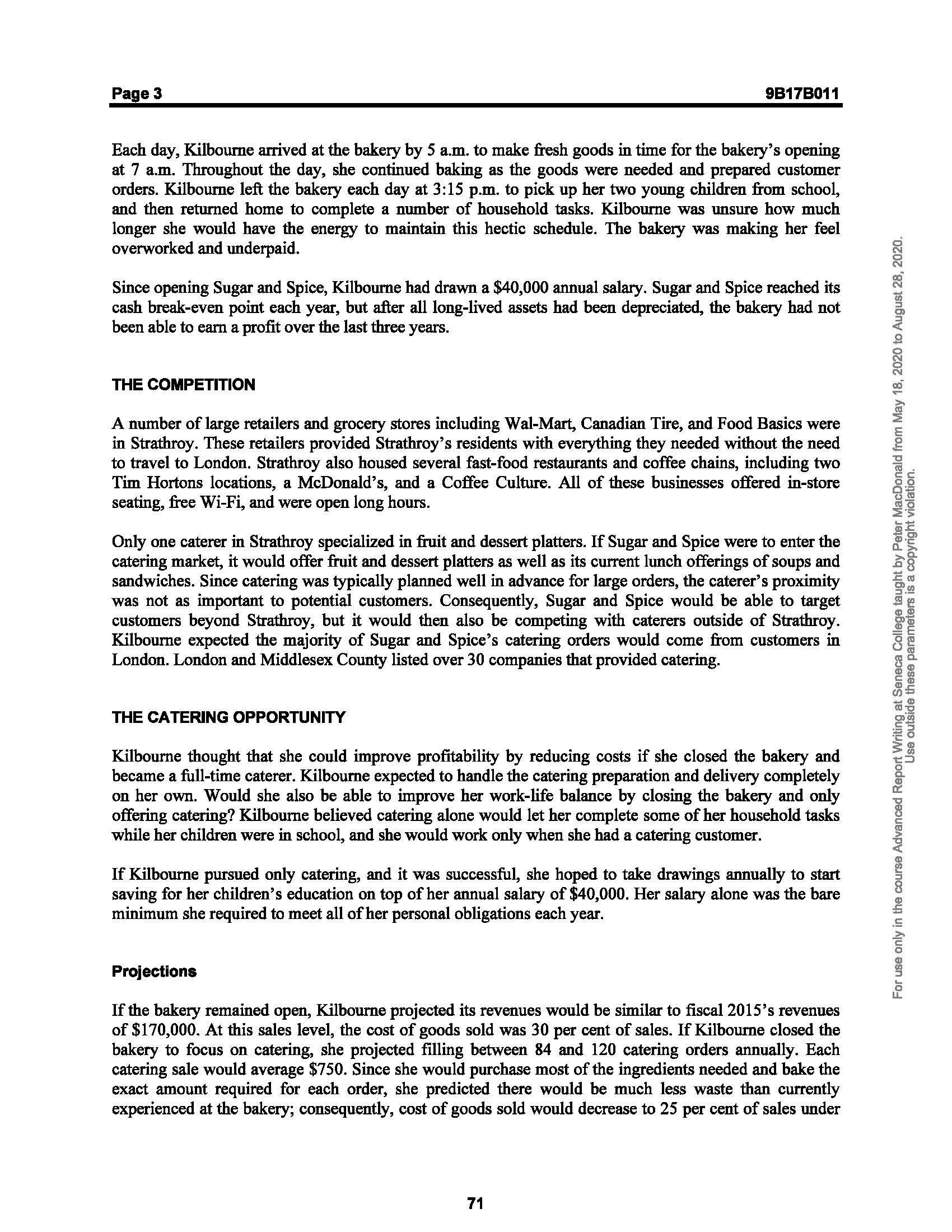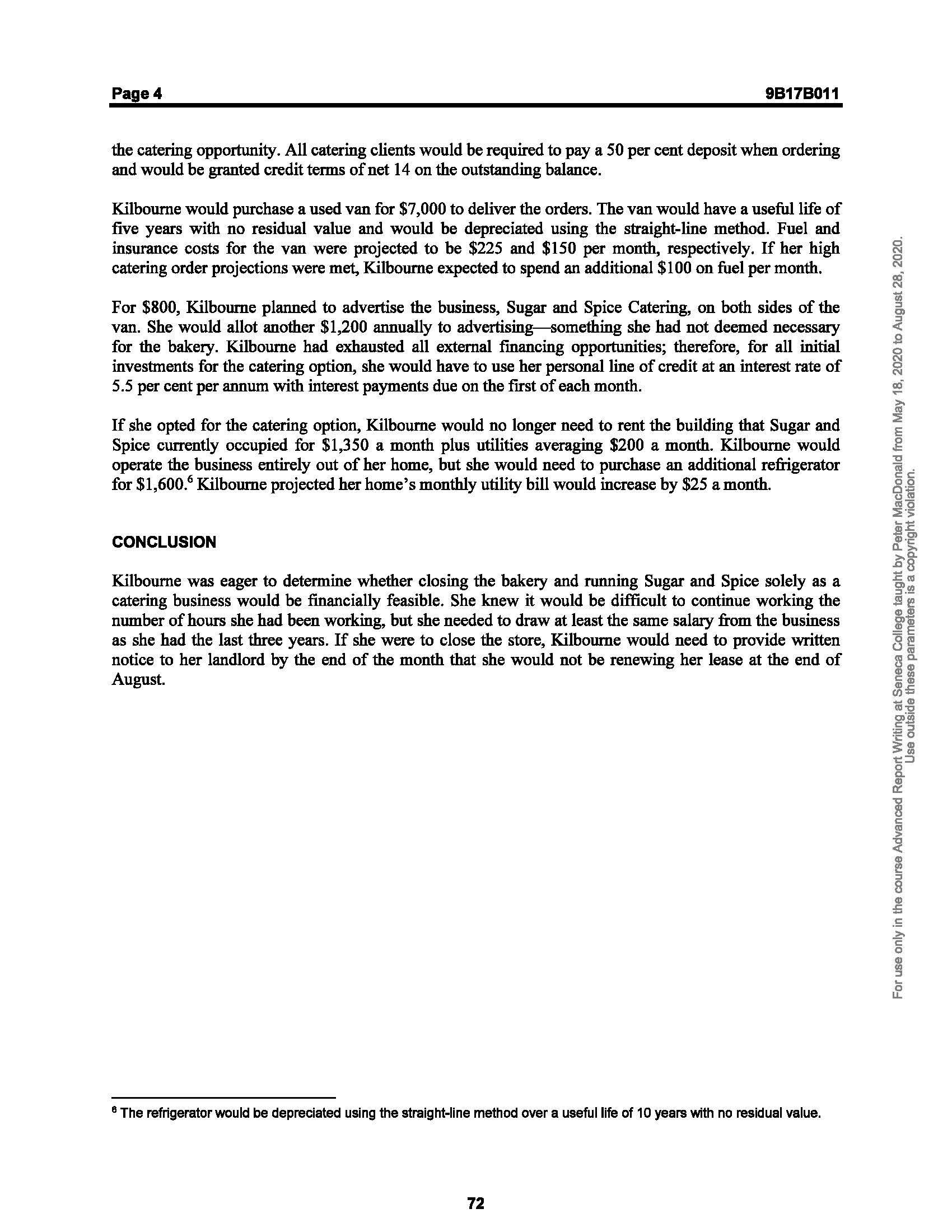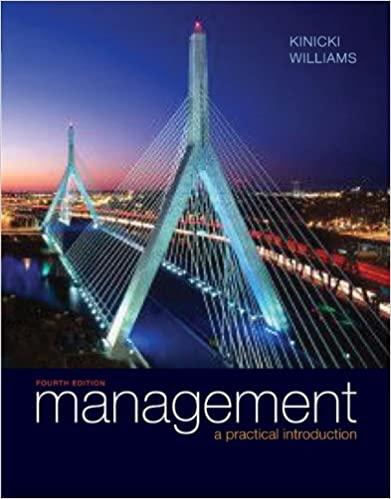IVEY Publishing 98178011 SUGAR AND SPICE BAKERY: THE CATERING OPPORTUNITY Jessica Welsh wrote this case under the supervision of Elizabeth M. A. Grasby solely to provide material for class discussion. The authors do not intend to illustrate either effective of ineffective handling of a managerial situation. The authors may have disguised certain names and other identifying information to protect confidentiality. This publication may not be transmitted, photocopied, digitized, or otherwise reproduced in any form or by any means without the permission of the copyright holder. Reproduction of this material is not covered under authorization by any reproduction rights organization. To order copies of request permission to reproduce materials, contact Ivey Publishing, Ivey Business School, Western University, London, Ontario, Canada, N6G ON1; (t) 519.661.3208, (e) cases@ivey ca, www.iveycases.com. Copyright @ 2017, Richard Ivey School of Business Foundation Version: 2019-10-29 On May 5, 2016, Rosetta Kilbourne, owner of Sugar and Spice Bakery (Sugar and Spice), was planning for her business's future. The lease on Kilbourne's bakery, located in Strathroy, Ontario, Canada, would expire at the end of August. Operating the bakery had become expensive, and Kilbourne wondered if it would be financially feasible to close the bakery and focus on catering events full time. STRATHROY-CARADOC Strathroy was located 40 kilometres west of a major southwestern city, London (population 367,000), and was the largest community within Middlesex County outside of London.' The town of Strathroy and the township of Caradoc amalgamated in 2001 to form the municipality of Strathroy-Caradoc (Strathroy). Of its 20,000 residents, 12,000 lived in the urban centre. Strathroy supported urban and rural areas with a For use only in the course Advanced Report Writing at Seneca College taught by Peter MacDonald from May 18, 2020 to August 28, 2020. outside these parameters is a copyright violation. range of businesses and industries, including agri-business, manufacturing, and logistical operations. With direct access to rail and trucking routes to the rest of southwestern Ontario and approximately 71 kilometres to the U.S. border, businesses had easy access to regional and international markets. Strathroy was home to Cuddy Farms, a global leader in producing and delivering commercial turkey eggs and poults." Each June, the town hosted Turkey Fest, a weekend event including a midway, carnival games, a turkey-calling contest, a battle of the bands, an antique car show, and a poult petting zoo. A popular event for the residents of Strathroy, the festival also attracted visitors from London and other towns within Middlesex County. A county was a geographical region of a country used for administrative or other purposes. 2"Doing Business: Home/Doing Business," Strathroy-Caradoc: Urban Opportunity-Rural Hospitality, accessed January 24, 2017, www.strathroy-caradoc.ca/en/Doing-Business.aspx?_mid_=29211. A poult was a young domestic chicken, turkey, pheasant, or other fowl being raised for food. 69Page 2 9317301 1 SUGAR AND SPICE BAKERY Rosetta Kilhoume Kilbourne had always had a passion for baking. From a young age, she had created her own recipes, which her family thoroughly enjoyed taste testing. Her dream had always been to open a bakery of her own, but she feared nancial instability and the risks of becoming self-employed. Aer graduating from college, Kilboume accepted what she thought was a secure position working as an administrative assistant for a security company based in London, Ontario. During the spring of 2007, Kilbcurne was laid off. The Purchase While Kilbourne contemplated her next steps, a small bakery, Sugar and Spice, was for sale in her hometown of Strathroy. The bakery served classic desserts, soups, and sandwiches and was open Monday to Friday from 7 arm. to 4 p.m. Kilbourne decided she had put her dream on hold for long enough; with nancial help from her father, Kilbourne purchased the bakery and opened in September 2007 as a sole proprietorship. The bakery was well known and had a good reputation within Strathroy, so Kilbourne kept its existing name and hours of operation, but altered the menu to include a wider variety of lunch and dessert options. Kilboume also continued to employ the bakery's existing full-time employees. Customers Sugar and Spice was a popular morning destination for local retirees of the Strathroy community. Several regular groups of customers would arrive together for their morning co'ee and a pastry. These customers typically would visit with each other at the bakery for approximately an hour and a half. On average, the retirees spent less than $54 per visit. Kilboume knew all of their names and regular ordersa personal touch that she believed kept the retirees coming to the bakery. Aside 'om the retirees, the bakery rarely had customers who stayed to consume their purchases. Sugar and Spice's main revenue came 'om take-out orders, made either in person or over the phone. It was common for phone orders to be received early in the morning for pick-up during the lunchtime rush between 11 am. and 1 p.m. These phone orders were primarily large orders over $150 om local businesses or community groups. Sugar and Spice did not offer delivery. Operations Kilbourne had two full-time employees who were paid $12.50 an hour and two part-time employees who were paid $11.25 an hour. Both full-time employees worked from 6 am. to 2:30 p.m.s each weekday, and one of the two part-time employees worked from 2 p.m. to 5 p.m. each weekday. During the morning and lunchtime rushes, Kilbourne desperately needed help to ll all orders, but often, for several hours in the afternoon, the part-time employee on duty did not help a single customer; in fact, the bakery's sales were frequently less than the total cost of wages for this employee's three-hour shi. 4 All cunency in Canadian dollars unless specied otherwise. 5 Full-time employees had one thirty-minute unpaid break during their shift. 70 For use only in the course Advanced Report Writing at Seneca College taught by Peter MacDonald from May 18. 2020 to August 28, 2020. Use outside these parameters is a copyright violation. Page 3 9317301 1 Each day, Kilboume arrived at the bakery by 5 am. to make fresh goods in time for the bakery's opening at 7 am. Throughout the day, she continued baking as the goods were needed and prepared customer orders. Kilboume left the bakery each day at 3:15 pm. to pick up her two young children from school, and then returned home to complete a number of household tasks. Kilboume was unsure how much longer she would have the energy to maintain this hectic schedule. The bakery was making her feel overworked and underpaid. Since opening Sugar and Spice, Kilbom'ne had drawn a $40,000 annual salary. Sugar and Spice reached its cash break-even point each year, but after all long-lived assets had been depreciated, the bakery had not been able to earn a prot over the last three years. THE COMPETITION A number of large retailers and grocery stores including Wal-Mart, Canadian Tire, and Food Basics were in Strathroy. These retailers provided Strathroy's residents with everything they needed without the need to travel to London. Strathroy also housed several fast-food restaurants and coffee chains, including two Tim Hortons locations, a McDonald's, and a Coee Culture. All of these businesses offered in-store seating, free WiFi, and were open long hours. Only one caterer in Strathroy specialized in 'uit and dessert platters. If Sugar and Spice were to enter the catering market, it would offer uit and dessert platters as well as its current lunch offerings of soups and sandwiches. Since catering was typically planned well in advance for large orders, the caterer's proximity was not as important to potential customers. Consequently, Sugar and Spice would be able to target customers beyond Strathroy, but it would then also be competing with caterers outside of Strathroy. Kilboume expected the majority of Sugar and Spice's catering orders would come from customers in London. London and Middlesex County listed over 30 companies that provided catering. THE CATERING OPPORTUNITY Kilboume thought that she could improve protability by reducing costs if she closed the bakery and became a full-time caterer. Kilboume expected to handle the catering preparation and delivery completely on her own. Would she also be able to improve her work-life balance by closing the bakery and only offering catering? Kilboume believed catering alone would let her complete some of her household tasks while her children were in school, and she would work only when she had a catering customer. If Kilboume pursued only catering, and it was successful, she hoped to take drawings annually to start saving for her children's education on top of her annual salary of $40,000. Her salary alone was the bare minimum she required to meet all of her personal obligations each year. Projections If the bakery remained open, Kilboume projected its revenues would be similar to scal 2015's revenues of $170,000. At this sales level, the cost of goods sold was 30 per cent of sales. If Kilboume closed the bakery to focus on catering, she projected lling between 84 and 120 catering orders annually. Each catering sale would average $750. Since she would purchase most of the ingredients needed and bake the exact amount required for each order, she predicted there would be much less waste than currently experienced at the bakery; consequently, cost of goods sold would decrease to 25 per cent of sales under 71 For use only in the course Advanced Report Writing at Seneca College taught by Peter MacDonald from May 18. 2020 to August 28, 2020. Use outside these parameters is a copyright violation. Page 4 9317301 1 the catering opportunity. All catering clients would be required to pay a 50 per cent deposit when ordering and would be granted credit terms of net 14 on the outstanding balance. Kilboume would purchase a used van for $7,000 to deliver the orders. The van would have a useful life of ve years with no residual value and would be depreciated using the straight-line method. Fuel and insurance costs for the van were projected to be $225 and $150 per month, respectively. If her high catering order projections were met, Kilboume expected to spend an additional $100 on fuel per month. For $800, Kilboume planned to advertise the business, Sugar and Spice Catering, on both sides of the van. She would allot another $1,200 annually to advertisingsomething she had not deemed necessary for the bakery. Kilboume had exhausted all external nancing opportunities; therefore, for all initial investments for the catering option, she would have to use her personal line of credit at an interest rate of 5.5 per cent per annum with interest payments due on the rst of each month. If she opted for the catering option, Kilboume would no longer need to rent the building that Sugar and Spice currently occupied for $1,350 a month plus utilities averaging $200 a month. Kilboume would operate the business entirely out of her home, but she would need to purchase an additional refrigerator for $1,600.6 Kilboume projected her home's monthly utility bill would increase by $25 a month. CONCLUSION Kilboume was eager to determine whether closing the bakery and running Sugar and Spice solely as a catering business would be nancially feasible. She knew it would be difcult to continue working the number of hours she had been working, but she needed to draw at least the same salary from the business as she had the last three years. If she were to close the store, Kilboume would need to provide written notice to her landlord by the end of the month that she would not be renewing her lease at the end of August. a The refrigerator would be depreciated using the straight-line method over a useful life of 10 years with no residual value. 72 For use only in the course Advanced Report Writing at Seneca College taught by Peter MacDonald from May 18. 2020 to August 28, 2020. Use outside these parameters is a copyright violation
